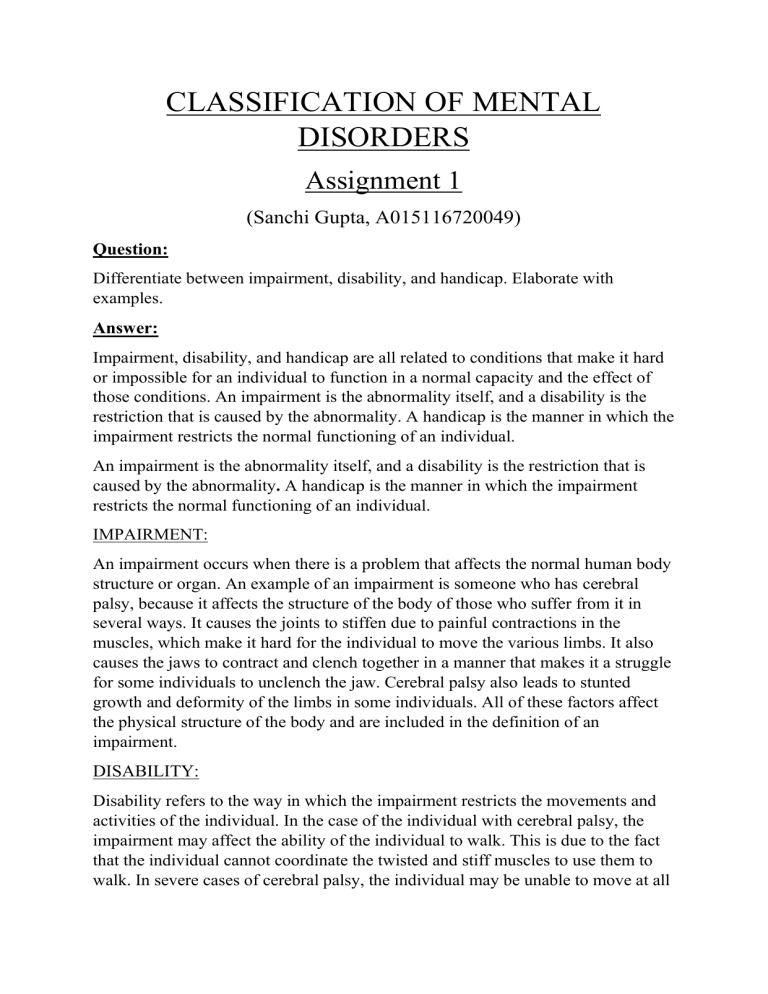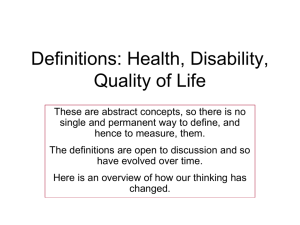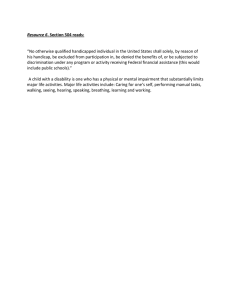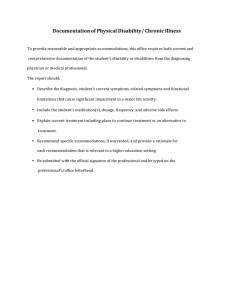
CLASSIFICATION OF MENTAL DISORDERS Assignment 1 (Sanchi Gupta, A015116720049) Question: Differentiate between impairment, disability, and handicap. Elaborate with examples. Answer: Impairment, disability, and handicap are all related to conditions that make it hard or impossible for an individual to function in a normal capacity and the effect of those conditions. An impairment is the abnormality itself, and a disability is the restriction that is caused by the abnormality. A handicap is the manner in which the impairment restricts the normal functioning of an individual. An impairment is the abnormality itself, and a disability is the restriction that is caused by the abnormality. A handicap is the manner in which the impairment restricts the normal functioning of an individual. IMPAIRMENT: An impairment occurs when there is a problem that affects the normal human body structure or organ. An example of an impairment is someone who has cerebral palsy, because it affects the structure of the body of those who suffer from it in several ways. It causes the joints to stiffen due to painful contractions in the muscles, which make it hard for the individual to move the various limbs. It also causes the jaws to contract and clench together in a manner that makes it a struggle for some individuals to unclench the jaw. Cerebral palsy also leads to stunted growth and deformity of the limbs in some individuals. All of these factors affect the physical structure of the body and are included in the definition of an impairment. DISABILITY: Disability refers to the way in which the impairment restricts the movements and activities of the individual. In the case of the individual with cerebral palsy, the impairment may affect the ability of the individual to walk. This is due to the fact that the individual cannot coordinate the twisted and stiff muscles to use them to walk. In severe cases of cerebral palsy, the individual may be unable to move at all due to damage in the brain and the resulting disconnect between the cognitive faculty necessary to learn how to function and the ability to control the limbs for movement. In relatively milder cases of cerebral palsy in which the individual retains full or partial cognitive faculties, such an individual might be able to learn how to move about using movement aids. The use of such aids reduces the level of the disability.] HANDICAP: The handicap stems from the extent of restriction that the impairment and disability impose on the individual. The criteria for measuring the handicap is by assessing how other normal people in such a situation would cope. As such, those who have cerebral palsy are handicapped in the sense that they cannot do things common to people in their age group and environment. For instance, if the individual who has cerebral palsy is eight years old, he or she is handicapped to the extent that he or she cannot play with children in the same age group, and in some cases, cannot even do everyday tasks like feeding him or herself. Example 1: Dyslexia is an example of learning impairment, a reading impairment in particular. Let’s say the student has an above-average intelligence as well as good vision and hearing. Therefore, the impairment is the brain’s inability to decode words to be able to read. The brain cannot correctly associate the sounds with the letter symbols. The inability to read is now the student’s learning disability. It can be improved by employing specific intervention programmes such as multisensory instruction in teaching reading. The person may experience various learning handicaps in school, and he or she may fail in class. For example, the student may not be able to complete the reading requirements in class. However, if certain adjustments are provided for the learner, such as taping lectures and listening to books on audiotapes, then he or she may fare well, similar to his or her peers. This will decrease the student’s handicap and will not interfere with his or her progress in school. Example 2: Cindy is an 8-year-old who has extreme difficulty with reading (severe dyslexia). She has good vision and hearing and scores well on tests of intelligence. She went to an excellent preschool and several different special reading programs have been tried since early in kindergarten. IMPAIRMENT While no brain injury or malformation has been identified, some impairment is presumed to exist in how Cindy's brain puts together visual and auditory information. The impairment may be inability to associate sounds with symbols, for example. DISABILITY In Cindy's case, the inability to read is a disability. The disability can probably be improved by trying different teaching methods and using those that seem most effective with Cindy. If the impairment can be explained, it may be possible to dramatically improve the disability by using a method of teaching that does not require skills that are impaired (That is, if the difficulty involves learning sounds for letters, a sight-reading approach can improve her level of disability). HANDICAP Cindy already experiences a handicap as compared with other children in her class at school, and she may fail third grade. Her condition will become more handicapping as she gets older if an effective approach is not found to improve her reading or to teach her to compensate for her reading difficulties. Even if the level of disability stays severe (that is, she never learns to read well), this will be less handicapping if she learns to tape lectures and "read" books on audiotapes. Using such approaches, even in elementary school, can prevent her reading disability from interfering with her progress in other academic areas (increasing her handicap).





